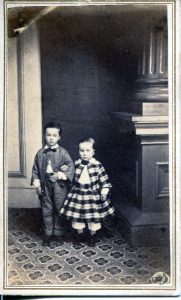Exploring Death and Mourning at Rose Hill
By Mel Oles, Visitor Services and Program Manager at Rose Hill Mansion and Johnston House
At historic sites we often tell stories of joy and success. However, to tell the whole human experience we must also share stories of loss and death. The families that lived at Rose Hill had moments of tragedy. These stories are both fascinating and sobering. This season’s exhibit The Good Death: Illness and Death in the 19th Century explores the customs of death and mourning during the Victorian era. To accompany The Good Death, the mansion will be decorated for mourning in September and October. We will also offer a specialty tour about mourning in October.
In the 1800s, illness and death were part of everyday life. Contaminated water, accidents, and contagious diseases saw most families experience serious sickness and loss. With little understanding of disease causes, doctors could only treat symptoms. The average life expectancy was 50 years, and one-third of children died before their tenth birthday. To reflect their grief, people went into mourning for a period of time and wore appropriate clothing. Though a constant presence, death was not feared. The ‘good death’ meant dying surrounded by loved ones and being mourned properly.
Few families in the 19th century were spared serious illness and loss, including the Swans at Rose Hill. Their son Otis Swan died in September 1864 from rheumatic fever at only five years old. This fall, the mansion will be dressed in mourning for Otis. A casket will be on display in the front parlor, while the dining room will be arranged for a wake. The windows and mirrors will be covered in black fabric. Visitors will discover how funerals were community events, marked by rituals and somber gatherings.
During the specialty tour, Mourning Otis, visitors will explore 19th-century ideas about illness and death and common practices people like the Swans used to cope with them. Mark your calendars for Saturday, October 19 and 26. Advanced registration is required and space is limited. To purchase tickets, visit historicgeneva.org.
While visiting Rose Hill don’t miss the exhibit, The Good Death: Illness and Death in the 19th Century. Among the items on the display are mourning jewelry made from human hair and various medicine bottles. Located in the East Tenant Cottage, the exhibit is free and open to the public Tuesday through Saturday from 10:00 am to 4:00 pm and Sunday from noon to 4:00pm. The exhibit will close on October 31, 2024.


Very interesting. I frequently walk by the tombstone marking the graves of the Swan children and think about the sadness the family would have experienced in losing those 3 little boys.